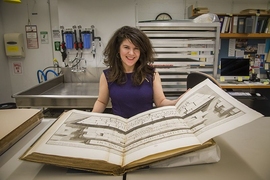When the team of researchers investigating a 17th-century postal trunk full of undelivered letters presented at MIT in April, the audience was taken aback — not by the content of the 2,600 letters from all over Europe, but by the team’s approach. The 600 letters that were not only undelivered but unopened — truly a motherlode for early modern historians — would remain unopened.
Why not just open the letters very, very carefully in order to read them? It’s a question that came up repeatedly when the Signed, Sealed, and Undelivered (SSU) project team spoke at the MIT Libraries for Preservation Week.
“If we opened them, then we wouldn’t have any more closed letters to study,” said Daniel Starza Smith, British Academy Postoctoral Fellow at Lincoln College, Oxford.
“Opening the letters in order to read them would irrevocably alter these precious artifacts,” said Jana Dambrogio, the Thomas F. Peterson (1957) Conservator at the MIT Libraries and an expert in minimal intervention approaches to conserving library and archival materials.
Now, two new grants are allowing Dambrogio and the SSU team, with the help of MIT scientists and engineers, to push the boundaries of imaging historic documents such as these. The projects, collectively titled “Unlocking History,” aim to employ cutting-edge technology to reveal the letters’ secrets and share the findings broadly.
Locked letters, open access
All of the letters in the Brienne collection, the documents examined in the SSU project, are examples of “letterlocking,” a centuries-old practice of folding and securing a letter to function as its own envelope. The physical details of the elaborately cut, folded, and sealed paper often have as much to tell us as the text.
“The documents are attempting to speak to you,” said Dambrogio, who pioneered the study of letterlocking. “But you have to know what the slits and folds and other details mean.”
A recent grant from the Gladys Krieble Delmas Foundation will enable the MIT Libraries’ Wunsch Conservation Lab, led by Dambrogio, to apply what they have learned to MIT’s own holdings and share the results with scholars around the world. The lab will categorize and digitize MIT’s historic documents, including handwritten correspondence from MIT founder William Barton Rogers. Data from the project will be stored in DSpace@MIT, the Institute’s repository for open access scholarship and research, and a new website will feature resources including instructional videos and a letterlocking dictionary.
“We can help more scholars to understand how letters once had multiple levels of physical, built-in security and authentication enhancements,” said Dambrogio.
Developing tools
With support from the Seaver Institute, the Wunsch Lab will also collaborate with Mike Tarkanian, a lecturer in the Department of Materials Science and Engineering (DMSE) and director of the Merton C. Flemings Materials Processing Laboratory, to fabricate a new tool to facilitate imaging letters that have been unfolded yet still retain important evidence in their slits, folds, and other details. This inexpensive physical support will allow imaging experts to digitize letters without flattening them, allowing both folds and text to be visible.
History unfolds
Another phase of the project supported by the Seaver Institute will partner the MIT Libraries Wunsch Lab; the SSU team; the Institute of Dentistry at Queen Mary University of London; and the MIT Computer Science and Artificial Intelligence Laboratory (CSAIL) to unfold virtually and read locked letters such as those in the Brienne collection.
The project draws on the expertise of Erik Demaine, professor of computer science and engineering and principal investigator in CSAIL, who is credited with starting the field of computational origami. He is joined by his father, Martin Demaine, the Angelika and Barton Weller Artist-in-Residence in the Department of Electrical Engineering and Computer Science, a CSAIL visiting scientist, and a technical instructor in the DSME Glass Lab. The father-and-son team, named 2013 Guggenheim Fellows for their work in origami, will oversee the development of algorithms to explore the complicated folding systems of each letter format found in the Brienne collection and to read the text of the letters.
Dambrogio has created a test set of 10 model letters like those found in the trunk, and Graham Davis and David Mills, researchers in x-ray microtomography imaging at Queen Mary University of London and collaborators with the SSU team, have already scanned these models, as well as 10 original letters from trunk, and sent the data to MIT for the programmers to begin their work. Once developed, the algorithms will allow the team to read the precious 17th-century artifacts without tearing the paper or breaking the seals.
When a key conservation philosophy — do nothing which cannot be undone — meets innovative fabrication and computation, it stretches the limits of historical inquiry. “Leaving the letters closed,” said Daniel Starza Smith, “is making us ask completely new questions.”










